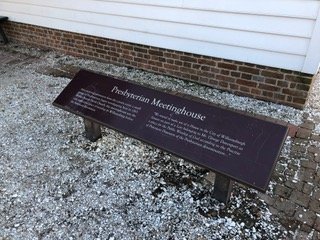Receive our blog posts in your email by filling out the form at the bottom of this page.
Much has been written here and elsewhere about the impact and legacy of Samuel Davies on Virginia Presbyterianism. After a 12-year ministry in Hanover County and surrounding parts, Davies left Virginia to assume the office of President of the College of New Jersey at in 1759 (he died at Princeton two years later). He had much occasion before his departure, however, to spend time in Williamsburg, Virginia, then the capital of the colony, in order to obtain his license to preach as a dissenter from the General Court, among other matters, and because his second wife was the daughter of the former mayor of Williamsburg.
George Davenport’s Presbyterian Meetinghouse at Colonial Williamsburg, Virginia.
It was on June 17, 1765 that a group of seventeen men petitioned the Court for permission to maintain a place of worship for dissenting Presbyterians at the home of George Davenport (d. 1766), who was a respected clerk for legislative committees at the House of Burgesses. That Presbyterian Meetinghouse, along with Davenport’s home and related buildings, has been restored as an historical landmark at Colonial Williamsburg.
Courtesy of Rich Brown.
Our friend Rich Brown recently brought Davenport’s Presbyterian Meetinghouse to mind. This place of worship was the only place one could meet for worship as a dissenter in Williamsburg prior to the American War of Independence in a district dominated by Bruton Parish Church (Anglican). Stephen Nichols on the 5 Minutes in Church History podcast has a segment titled “17 in 1765” which tells the story of how this important landmark in the history of religious freedom developed. Whereas the birthplace of Samuel Davies, as we have noted before, is in a state of great disrepair, we are thankful that Colonial Williamsburg has seen fit to restore and maintain this historical site, the Davenport Presbyterian Meetinghouse for today’s generation to remember a key time and place from the past in the history of Virginia Presbyterianism.
Interior signage at the Davenport Presbyterian Meetinghouse (courtesy of Rich Brown).
Davenport did not live long after approval for his house of worship was granted. His wife Catherine continued to maintain the property, and the congregation, though without a regular pastor, continued with preaching by various Presbyterian ministers, including (in 1767), the notable James Waddel. See more about George Davenport at his page on Log College Press, and if you are in the area of Colonial Williamsburg, be sure to check out the Presbyterian Meetinghouse, the Davenport House, the Davenport Stable, the Davenport Kitchen and the Davenport Stable, and consider the legacy that endures.




